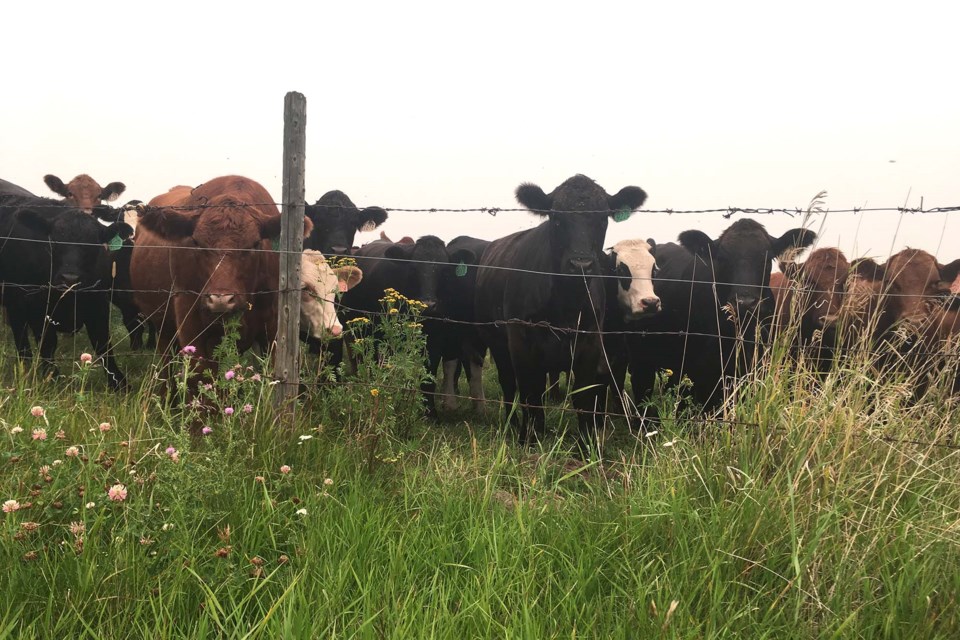Sturgeon County farmers can cut the carbon footprint of their cows if they move them around more as they graze, recent research from the University of Alberta suggests.
U of A Ecology Prof. Mark Boyce and his team published a study in Agronomy last November on the effects of adaptive multi-paddock grazing on greenhouse gas emissions from soil.
Boyce said grasslands contain about 33 per cent of the world’s carbon, and about 70 per cent of them are being tilled for agriculture.
“In doing so, we lose vast amounts of carbon,” he said, as buried biomatter is dug up to rot, creating heat-trapping greenhouse gases. We also destroy grassland bird habitat, which has made those birds amongst the most imperilled birds on Earth.
Adaptive multi-paddock grazing (AMP) is a technique where farmers divide a field into many small paddocks and frequently rotate their animals between them, giving each paddock long periods of rest between grazing. Boyce said researchers have found this technique promoted rapid regrowth and enhanced soil quality, and his team wanted to see if it could also boost carbon sequestration.
Dirt experiment
Boyce said this study was part of a bigger project he was running with 60 ranches in Alberta, Saskatchewan, and Manitoba, some of which were in Sturgeon County.
For this paper, Boyce and his team took 11 Alberta ranges that used AMP and paired them with 11 nearby conventional ranches for comparison. They took soil samples from each ranch, stuck the dirt in Mason jars, and baked the dirt at constant moisture levels for 102 days at either 5 C or 25 C. The team monitored changes in the concentration of greenhouse gases in the jars over time using a gas chromatograph.
The team found that AMP-treated soils absorbed 1.5 times more methane than conventional dirt.
Boyce said this is exciting news, as cows are a significant source of methane (which has 25 times more global warming potential than CO2 over a hundred-year period).
“What we’ve found is the soil actually absorbs methane to ameliorate that effect of the cattle.”
Boyce said the team wasn’t sure if the soil could absorb all a cow’s methane, but knew it took in more with AMP than without. They’re also not sure why AMP increases methane absorption: it could be that concentrating cows grinds more plant matter into the dirt to store carbon, or that intense grazing favours hardier plants with more carbon-storing roots.
Triple-win, says farmer
Sturgeon County farmer Delton Jubinville was not involved with Boyce’s study but said he wasn’t surprised with its results. He’s used AMP on his farm for the last four years, and found that it has made his fields more drought-proof and his cows bigger and healthier. AMP is more labour-intense than regular grazing, but he believes it paid off, as it let him stock more cows per acre.
“This is a true win-win-win all the way around,” Jubinville said.
“It’s a win for the environment, a win for the animals and a win for the farmers.”
Less than 10 per cent of farmers currently use AMP on their lands, but Boyce said carbon credits could give farmers a financial push to try it out. More lands managed with AMP would mean less tillage, more carbon storage and more habitat for grassland birds.
“Agriculture has the potential to make a huge difference in that carbon balance, and we’re not taking advantage of it,” Boyce said, in part because so little attention had been paid to soil as a carbon sink.
“If we were to use rotational grazing across the Great Plains, we could offset a very substantial amount of industrial emissions.”
Boyce’s paper can be found at bit.ly/315xx1B.




